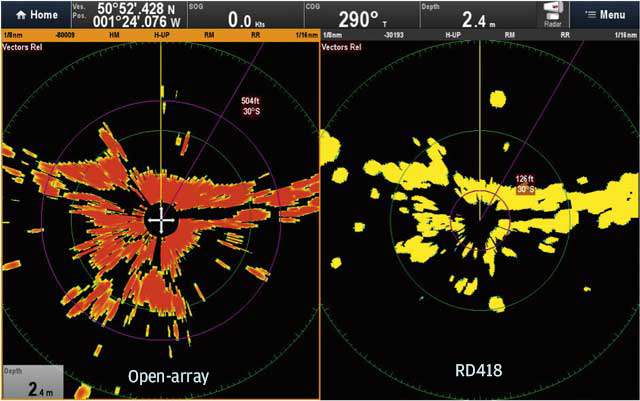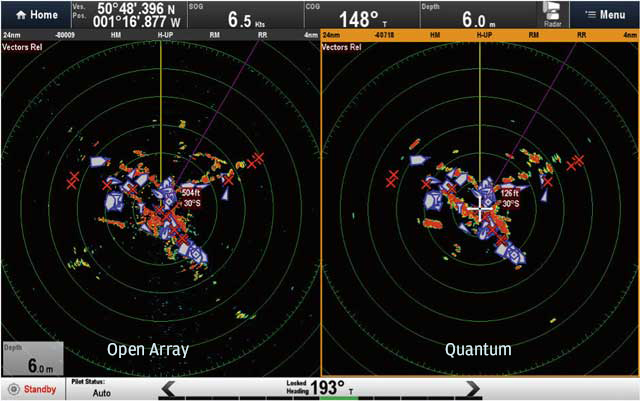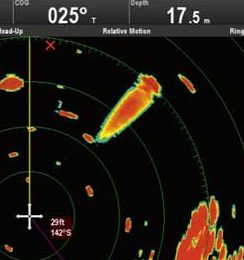Exclusive: We take to the Solent to compare the performance of the new Raymarine Quantum pulse-compression radar with a same-size conventional radar and a 4ft open array HD radar
The technique of pulse compression in radar is not new: the original patents go back to the 1940s, but it is new to leisure radars. One of the requirements to implement this technology in small craft is to move away from magnetron transmitters to all solid-state (silicon), and it has only recently become cost-effective to do this in the leisure/small commercial market. This article describes the technique and the benefits it should bring, followed by a sea trial to see how the Raymarine Quantum radar measures up against a standard digital radar and an open array HD radar.
Pulsed radar
Pulsed radar works by sending out a short burst of radio energy and then listening for reflections: it can work out the range by measuring the time from the transmit pulse to the received echo. By knowing which way the antenna is pointing, it can work out the bearing and thus know where to put a target on the screen.
The traditional compromise
Apart from the reflecting characteristics of the target, two major factors determine the performance of a pulsed radar. The first is the beamwidth of the antenna, which sets the ability to distinguish between targets at the same range on slightly different bearings. The larger the antenna, the narrower the beam, and hence the better the discrimination. There are possibilities in processing to artificially sharpen the beamwidth, but ‘larger is better’ still remains the rule.
The second factor concerns the characteristics of the pulse. The ability to see a target depends on the characteristics of the target and the amount of energy we put on the target. Energy is the pulse power multiplied by the duration. For a given power, a longer pulse will have more energy than a shorter one, so a longer pulse will be better at picking up small targets. There is a downside though, as the longer the pulse the less able it is to differentiate between targets on the same bearing at slightly different ranges.
A conventional pulsed radar deals with this by transmitting a fairly long pulse (around one-millionth of a second) at long ranges so you get the best target detection at the expense of discrimination, and it progressively shortens the pulse as the radar range is reduced. This all happens automatically as you change range, as you might become aware if a target on a higher range suddenly becomes two when you switch the range down.
Pulse compression
Pulse compression describes a range of techniques whereby a long pulse is transmitted and then processed in the receiver to look like a short pulse. By transmitting a very long pulse (compared to a normal pulsed radar), it is possible to have low power but still high energy and so be as good at spotting targets as a traditional high-power pulse radar. In order for the long pulse to have the same information content as the short, it must be swept in frequency (the so-called ‘chirp’). There are many ways of achieving the sweep, from a simple sweep to stepped or coded steps as used by the military.
The mathematics of this rapidly become daunting, but the easiest to visualise is a stepped sweep. Imagine a long pulse made of a series of stepped frequencies: this is then transmitted, and reflects back from the target just as transmitted. In the receiver, a special filter delays each step progressively until they are all at the same time, and then adds them together. Effectively, we have taken a row of ‘bricks’ laid horizontally and now stacked them vertically. We now have something that looks like a short high-power pulse.

We have taken a row of ‘bricks’ laid horizontally and stacked them vertically
Essentially we have used processing to overcome the traditional radar trade-off between pulse width and discrimination. To achieve the swept frequency we need to be able to control the frequency of the transmitter: this can’t be done with a magnetron, so it is necessary to go solid-state; this in turn can be done as the transmitter is now low-power. Apart from making ‘chirp’ possible, this has the benefits of reduced weight, power consumption and improved reliability as there are no high voltages. Over time, all small boat radars will become solid-state and use this or similar techniques.
Sea Trials
Tests were done in the Solent on Trinity Star, a Nelson 42. The performance of Quantum was compared with a similar-size conventional radar, a Raymarine RD418D.
The aspects of interest were short-range performance, mid-range clarity and discrimination, long-range performance and the ability to trigger a racon. Quantum was tested on an outbound leg from Hythe to the Brambles in the centre of the Solent to the Hamble, where Quantum was swapped for the RD418D and the tests repeated in reverse. The 4ft open-array HD radar on Trinity Star was used as a reference but was expected to give superior bearing discrimination from the much bigger antenna.

Quantum and the open-array radar

The Raymarine Digital RD418D traditional radar
| RD418D | Quantum | |
| Weight | 9.5kg | 5.6kg |
| Power consumption: Transmit | 40W | 17W |
| Power consumption: Standby | 20W | 7W |
| Pulse peak power | 4,000W | 20W |
Short-range performance
A traditional pulse radar is expected to have a blind zone around your vessel equal to a pulse width which equates to 30-50m with the radar on short range. This is due to the time it takes for a magnetron radar to switch from transmit to receive after sending the pulse. Broadband radars overcome this as they transmit and receive simultaneously and achieve very good minimum ranges.
Short-range performance was tested in Hythe Marina, which is a demanding location for radar with lots of large buildings close by.

The Hythe test location with Quantum overlaid on chart

The first comparison between Quantum and the open array is a win for Quantum (above). The very noticeable hole in the centre on the open array (72ft diameter) is absent with Quantum, and it was possible to see targets as close as 15ft on Quantum. The shorter pulse length of Quantum also gives a better picture, but the open array has a slight advantage from antenna size in bearing discrimination. The RD418 again shows the hole in the middle, and there are fewer, less-sharp targets displayed (below).

Comparison Result
In all cases, settings are at ‘auto’ rather than tweaked for best performance in order to make the tests fair. In short range, the Quantum is as good as if not slightly better than the open array.
Mid-range performance

From the entrance to the Hamble, there are a range of big targets
A favourite test spot is at the entrance to the Hamble, just by the inner pair of piles with the speed warning boards. From here there are a range of big targets from Fawley power station, low-lying gravel banks at Warsash and small marker piles for the channel as well as the Warsash jetty; everything you could wish for to compare performance.

Comparing performance, at mid range the open array shows the advantage of the bigger antenna. You can see how the target bottom centre of the screen is stretched more by Quantum although there is still some effect on the open array, with side lobes becoming visible.

This image, comparing the open array with the RD418, was taken a few minutes later, so moving targets are in different places. It is noticeable in the second shot that the RD418 is not picking up the channel markers nearly as well as Quantum and that the detail of shore targets is better on Quantum.
Comparison Result
At mid-range then, the 4ft open array HD set starts to show some advantage purely from antenna size, but Quantum is doing very well – and significantly better than the RD418.
Long-range performance

To compare long range we went to the Calshot North cardinal in the centre of the Solent from where there is a good view all the way down to the Needles.
Looking down towards the Needles at 15 miles range (two o’clock position in the picture right), Quantum was giving similar returns to the 4ft open array even though it is mounted 1m lower. This performance was better than I expected. Both are picking up a target at 20 miles at the
4 o’clock position. Realistically, a small boat radar will not see anything much beyond the 24-mile range as the target needs to be both a good reflector and very tall (100m plus) to show.

On the six-mile range, Quantum was still giving a very good account of itself, and the only real difference between it and the open array was how solid the land echoes were.

The final picture compares open array to RD418. We noted the returns from the Needles area were not as good on the RD418 compared to Quantum. Unfortunately, we grabbed a 12-mile shot rather than a 6 and 24 (the weather was beginning to make itself known!), but it’s good enough to show that although the beam width is specified at 4.9° for both Quantum and RD418, the view to the 12 o’clock up Southampton Water shows Quantum to be giving better performance, presumably due to some beam sharpening in the processing.
Comparison Result
On long range, the 4ft array has the edge – but that is to be expected from antenna size and the extra 1m height. Quantum performs very well indeed against the conventional radome, both on extreme range.
Weather

The 4ft open array clearly shows a rain squall to port
A standard pulsed radar is good at picking up rain squalls and will show these as a bright area on the screen. To find out if there is anything solid inside, a control called Rain Clutter allows you to filter out the rain echoes and leave the solid one. This is particularly necessary on the basic RD418 radar, but less so on the HD open array which shows returns as a colour palette, with hard targets showing red and mushy rain returns as yellow/blue/green.
The pulse processing in Quantum seems to filter rain returns out without being asked, so a weather mode is included to emphasise rain returns.
The weather on our test day was very squally, with short and intense rain storms. The image from the open array (left) shows that it is picking up the squall; the fact that it is in red shows the intensity. Quantum largely filtered it out in Harbour Mode, but switching to Weather Mode, gave a similar return to the open array.

In Harbour Mode Quantum only hints at the presence of the squall.

Switching to Weather Mode gave a much better result
Racons
 One of the concerns with low-power long-pulse radars is their ability to trigger racons. These are radar transponders fitted to navigation marks: around the Solent, the Nab, West Brambles and Bridge cardinals have them. They are triggered by your radar and return a strong signal to make the mark show up well on your screen. In the Solent, they all transmit the Morse letter T (one long dash), so the buoy and its racon response will show as an exclamation mark.
One of the concerns with low-power long-pulse radars is their ability to trigger racons. These are radar transponders fitted to navigation marks: around the Solent, the Nab, West Brambles and Bridge cardinals have them. They are triggered by your radar and return a strong signal to make the mark show up well on your screen. In the Solent, they all transmit the Morse letter T (one long dash), so the buoy and its racon response will show as an exclamation mark.
PBO Verdict
Quantum is half the weight, uses less than half the power and returns a creditable performance even against its big brother, the 4ft open array. Pulse compression technology has been in use by the military for a while, and will in the coming years become the standard technology for small craft radars, with production of magnetron-based radars being slowly phased out. The emphasis will shift from hardware to software, and we can expect to see new and advanced features appearing on our radars.
Alan Watson




